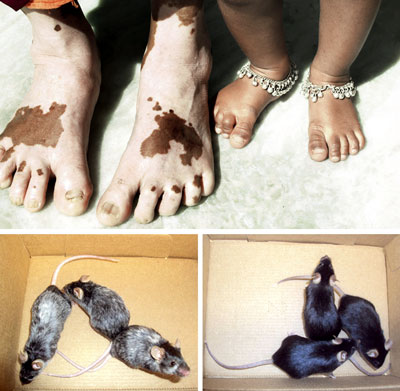First treatment for vitiligo skin ailment
Vitiligo was made famous by Michael Jackson who lost his dark skin tone to the disease. Researchers have now found a cure for the skin disorder by using a modified protein.
Researchers from Loyola University and Chicago Stritch School of Medicine have developed a genetically modified protein that dramatically reverses the skin disorder vitiligo in mice, and has similar effects on immune responses in human skin tissue samples.
The modified protein is potentially the first effective treatment for vitiligo, which causes unsightly white patches on the face, hands and other parts of the body.
Loyola University Chicago has submitted a patent application for the protein, and researchers are seeking regulatory approval and funding for a clinical trial in humans.
Caroline Le Poole and colleagues describe the modified protein in the journal Science Translational Medicine.
Le Poole is a professor in Loyola’s Oncology Institute and in the departments of Pathology and Microbiology and Immunology.
Vitiligo affects millions of people around the world, about 1 in 200 people. It is an autoimmune disease, in which the immune system goes into overdrive and kills pigment cells, which give skin its colour.
Previous studies have found that a protein called HSP70i plays a vital role in the autoimmune response that causes vitiligo. (HSP70i stands for inducible heat shock protein 70)
HSP70i consists of 641 building blocks called amino acids. Le Poole and colleagues genetically modified one of these amino acids to create a mutant HSP70i.
This mutant protein supplants normal HSP70i, thereby reversing vitiligo’s autoimmune response.
Resarchers Jeffrey Mosenson and Andrew Zloza gave mutant HSP70i to mice that developed vitiligo, and the results were striking. Mouse fur – affected by vitiligo – had the coloring of a salt-and-pepper beard.
But when the mice were vaccinated with mutant HSP70i, the fur turned black. “The mice look normal,” Le Poole said.
Some of the effects seen in mice also were seen in human skin specimens. There are no long-term effective treatments for vitiligo. Steroid creams sometimes return some colour to affected skin.
But this treatment also thins the skin, and can cause streaks or lines. Bright lights, similar to tanning booths, also can return colour, but can cause sunburns and other side effects, including vitiligo.
Skin grafts transfer skin from unaffected areas to the white patches, but can be painful and expensive. None of the existing treatments effectively prevent vitiligo from progressing.
Le Poole and colleagues wrote that mutant HSP70i “may offer potent treatment opportunities for vitiligo.”



Leave a reply